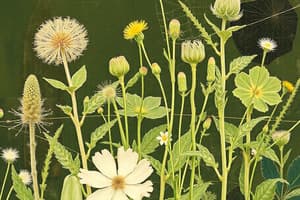Podcast
Questions and Answers
What is the scientific name for Corn?
What is the scientific name for Corn?
- Ipomoea triloba
- Lantana camara
- Zea mays (correct)
- Imperata cylindrica
Which of the following is NOT a characteristic of weeds?
Which of the following is NOT a characteristic of weeds?
- They can adapt to adverse environmental conditions
- They persist and resist control measures
- They have slow vegetative growth (correct)
- They produce seeds efficiently
What are common weeds characterized by?
What are common weeds characterized by?
- Expensive management
- Difficult control
- Ease of control (correct)
- High destructiveness
Which plant is known as Makahiya?
Which plant is known as Makahiya?
What type of effects do weeds have according to their categorization?
What type of effects do weeds have according to their categorization?
Which of the following is an example of an escape plant?
Which of the following is an example of an escape plant?
Which common weed is also known as Cogon grass?
Which common weed is also known as Cogon grass?
What is one significant harmful effect of weeds?
What is one significant harmful effect of weeds?
What is the primary focus of weed science?
What is the primary focus of weed science?
Which characteristic allows weeds to outcompete crops effectively?
Which characteristic allows weeds to outcompete crops effectively?
What is a primary characteristic of grasses based on their gross morphology?
What is a primary characteristic of grasses based on their gross morphology?
What defines a weed in the context of crop production?
What defines a weed in the context of crop production?
What is a noxious weed?
What is a noxious weed?
In which family do sedges belong?
In which family do sedges belong?
How do broadleaves primarily differ from grasses and sedges?
How do broadleaves primarily differ from grasses and sedges?
How does the herbicide 2,4-D function in relation to weeds?
How does the herbicide 2,4-D function in relation to weeds?
Which statement describes 'volunteer crops'?
Which statement describes 'volunteer crops'?
What is a common feature of the root systems found in grasses?
What is a common feature of the root systems found in grasses?
Which process involves the transfer of male gametes to female ovules in flowering plants?
Which process involves the transfer of male gametes to female ovules in flowering plants?
Why are weeds considered undesirable in crop production?
Why are weeds considered undesirable in crop production?
Which of the following is NOT a characteristic of weeds?
Which of the following is NOT a characteristic of weeds?
What distinguishes sedge stems from those of grasses?
What distinguishes sedge stems from those of grasses?
What type of root system do most broadleaved plants exhibit?
What type of root system do most broadleaved plants exhibit?
What is a reproductive characteristic of weeds as mentioned in the content?
What is a reproductive characteristic of weeds as mentioned in the content?
What is the main characteristic of asexual reproduction in plants?
What is the main characteristic of asexual reproduction in plants?
Which of the following is NOT a modification commonly associated with vegetative reproduction?
Which of the following is NOT a modification commonly associated with vegetative reproduction?
What role do adaptive structures play in dispersal?
What role do adaptive structures play in dispersal?
Which dispersal agent is characterized by seeds that can remain viable after passing through an animal's digestive system?
Which dispersal agent is characterized by seeds that can remain viable after passing through an animal's digestive system?
How does wind contribute to seed dispersal?
How does wind contribute to seed dispersal?
Which of the following is a key determinant for weed dispersal?
Which of the following is a key determinant for weed dispersal?
What is meant by a 'dispersal unit' in the context of plant dispersal?
What is meant by a 'dispersal unit' in the context of plant dispersal?
Why is man considered one of the best agents of seed dispersal?
Why is man considered one of the best agents of seed dispersal?
What is referred to as the Critical Period of Competition?
What is referred to as the Critical Period of Competition?
Which factor significantly influences the competing ability of a crop against weeds?
Which factor significantly influences the competing ability of a crop against weeds?
What does the Critical Threshold Level indicate?
What does the Critical Threshold Level indicate?
How do allelochemicals affect plants?
How do allelochemicals affect plants?
Why is timing important in the application of fertilizers concerning weed control?
Why is timing important in the application of fertilizers concerning weed control?
Which statement about weed control methods is true?
Which statement about weed control methods is true?
What role does soil fertility play in the competition between crops and weeds?
What role does soil fertility play in the competition between crops and weeds?
What is a major consequence of high weed intensity in a crop field?
What is a major consequence of high weed intensity in a crop field?
Study Notes
Weed Science Overview
- Focuses on the study and management of weeds in crop protection.
- Evolved from plant physiology, notably with the discovery of the herbicide 2,4-D, which functions as a growth regulator at low concentrations.
Definition of Weeds
- Classified as plants growing in undesired places, competing with cultivated plants.
- Weeds reduce crop yield by competing for land, light, water, and nutrients.
- Their classification is based on subjective human perception, often carrying a negative connotation.
Characteristics of Weeds
- Weeds are adept at outcompeting crops due to several traits:
- High seed production with long-term soil viability.
- Rapid root spread and growth.
- Adaptability to disturbed environments.
Noxious Weeds
- Highly competitive and harmful even at low populations, affecting crop yields.
- Examples include Chromolaena odorata (Hagonoy or Devil weed).
Volunteer Crops
- Plants that grow independently without intentional cultivation.
- Example: Zea mays (Maiz or Corn).
Escape Plants
- Non-native ornamental plants that establish wild populations through dispersal.
- Example: Lantana camara (Kanding-kanding).
Common Weeds
- Frequently found in fields, typically easier to control and less destructive.
- Examples:
- Imperata cylindrica (Cogon grass)
- Ipomoea triloba (Morning glory)
- Mimosa pudica (Makahiya)
- Cyperus rotundus (Purple nutsedge)
Unique Characteristics of Weeds
- Rapid vegetative growth and significant root production.
- Efficient early seed production and adaptation to adverse conditions.
- High damage potential, even in low densities.
- Resistance to control measures.
Harmful Effects of Weeds
- Decrease both the quantity and quality of crop yields.
- Increase production costs in agriculture.
Classification Based on Morphology
- Grasses: Family Gramineae (Poaceae), characterized by succulent stems and fibrous roots, e.g., Eleusine indica, Echinochloa glabrescens.
- Sedges: Family Cyperaceae, with triangular stems and fibrous roots, often creeping.
- Broadleaves: Diverse families, identified by expanded leaves with netted venation and tap or fibrous roots, e.g., Centella asiatica, Euphorbia hirta.
Reproduction and Establishment
- Two primary plant propagation methods:
- Sexual (Seeds): Involves gamete production, pollination, and fertilization.
- Asexual (Vegetative): Growth from organs like stems or rhizomes; can yield many new plants.
Seed Dispersal Mechanisms
- Wind: Seeds with adaptable structures, such as dandelion seeds.
- Water: Seeds that float, common in aquatic environments.
- Animals: Seeds that pass through the digestive systems of animals and remain viable.
- Human activity: Deliberate or accidental dispersal of seeds.
Competition in Cropping
- Critical Period of Competition: Timeframe in which crops are most sensitive to weed presence, critical for maintaining yield.
- Critical Threshold Level: Density of weeds that, if exceeded, results in significant yield loss.
Factors Affecting Crop Competition
- Timing of weed germination relative to crops.
- Intensity and specific species of weeds present.
- Soil fertility and nutrient management.
- Allelopathy: Chemical interactions between different plant species impacting growth.
Allelochemicals
- Produced by plants that affect germination and growth of others through biochemical interference in various physiological processes, including:
- Cell elongation, photosynthesis, respiration, and nutrient uptake.
Management of Weed Populations
- Effective weed control requires diverse strategies tailored to specific weed species.
Studying That Suits You
Use AI to generate personalized quizzes and flashcards to suit your learning preferences.
Related Documents
Description
Explore the essentials of weed science within crop protection in this engaging quiz. Learn about the impact of weeds, their control mechanisms, and the significance of herbicides like 2,4-D. This quiz is designed for students studying CPRT41 principles and is a vital component of effective agricultural practices.




